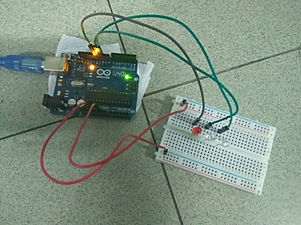
Learning Electricity using Arduino-Android based Game to Improve STEM Literacy
Abstract
Full Text:
DOWNLOAD PDFReferences
Afriana, J., Permanasari, A., & Fitriani, A. (2016). Project Based Learning Integrated to STEM to Enhance Elementary School’s Students Scientific Literacy. Jurnal Pendidikan IPA Indonesia, 261-267.
Anwari, I., Yamada, S., Unno, M., Saito, T., Suwarma, I. R., Mutakinati, L., & Kumano, Y. (2015). Implementation of authentic learning and assessment through stem education approach to improve students’ metacognitive skills. K-12 STEM Education, 1(3), 123-136.
Avsec, S., & Jamšek, J. (2018). A path model of factors affecting secondary school students’ technological literacy. International Journal of Technology and Design Education, 28(1), 145-168.
Bybee, R. W. (2013). The case for STEM education: Challenges and opportunities. NSTA press.
Cambridge International Examinations. (2013). Cambridge IGCSE Physics Syllabus. United States: Board Examination Systems (BES) Pilot.
Cao, Y., & Brizuela, B. M. (2016). High school students’ representations and understandings of electric fields. Physical Review Physics Education Research, 12(2), 020102.
Carro, G., Castro, M., Sancristobal, E., Diaz, G., Mur, F., Latorre, M., ... & Gillet, D. (2014, April). The color of the light: A remote laboratory that uses a smart device that connects teachers and students. In Global Engineering Education Conference (EDUCON), 2014 IEEE (pp. 854-860). IEEE.
Prima, E. C., Oktaviani, T. D., & Sholihin, H. (2018, May). STEM learning on electricity using arduino-phet based experiment to improve 8th grade students’ STEM literacy. In Journal of Physics: Conference Series (Vol. 1013, No. 1, p. 012030). IOP Publishing.
Creswell, J. W. (2012). Educational Research (Fourth Edition ed.). Boston: Pearson.
Creswell, J. W. (2012). Educational research: planning, conducting, and evaluating quantitative and qualitative research. Boston: Pearson Education, Inc.
Fraenkel, J., Wallen, N., & Hyun, H. (2011). How to Design and Evaluate Research in Education. New York: McGraw Hill.
Fundoino. (2016). Tutorial For Arduino. Fundoino Service Team.
Grunert, J., & Adams, D. S. (2016). Increasing Engineering Literacy among Non-Engineering Students. 2016 ASEE Annual Conference & Exposition (pp. 1-13). New Orleans, Louisiana: ASEE PEER.
Huang, B. (2015). Open-source Hardware – Microcontrollers and Physics Education - Integrating DIY Sensors and Data. Washington: ASEE PEER.
Jolly, A. (2014). Six characteristics of a great STEM lesson. Education Week.
Laboy-Rush, D. (2011). Integrated STEM Education through Project Based Learning. Portland, United States of America: Sematinticscholar.org.
Leibowitz, D. (2016). Supporting Mathematical Literacy Development: A Case Study of the Syntax of Introductory Algebra. Interdisciplinary Undergraduate Research Journal, 7-13.
Lou, S.-J., Shih, R. C., Diez, C. R., & Tseng, K. H. (2011). The impact of problem-based learning strategies. International Journal Technology and Education, 21, 195-215.
McFarland, J., Hussar, B., Brey, C. d., Snyder, T., Wang, X., Wilkinson-Flicker, S., . . . Hinz, S. (2017). The Condition of Education 2017. Washington DC: U.S. Department of Education.
Meluso, A., Zheng, M., A, H., & Lester, J. (2011). Enhancing 5th graders’ science content knowledge and self-efficacy through game-based learning. Computer & Education, 487-504.
Monk, S. (2010). 30 Arduino Projects for The Evil Genius. New York: Mc Graw Hill.
Mulhall, P., McKittrick, B., & Gunstone, R. (2001). A Perspective on the Resolution of Confusions in the Teaching of Electricity. Research in Science Education, 31, 575-587.
National Research Council (2013). Monitoring Progress Toward Successful K-12. A Nations Advancing?. Washington, DC: National Academies Press.
Ong, F., Mclean, J., & Greco, J. (2014). INNOVATE A Blueprint for Science, Technology, Engineering, and Mathematics in California Public Edu. California: California Department of Education.
Prima, E. C., Putri, A. R., & Rustaman, N. (2018). Learning Solar System Using PhET Simulation to Improve Students' Understanding and Motivation. Journal of Science Learning, 1(2), 60-70.
Prima, E. C., Putri, C. L., & Sudargo, F. (2017). Applying Pre and Post Role-Plays supported by Stellarium Virtual Observatory to Improve Students’ Understanding on Learning Solar System. Journal of Science Learning, 1(1), 1-7.
Rapini, S. (2012). Beyond Textbooks and Lectures: Digital Game-Based Learning. McLean, Virginia: Texas A&M Bush School of Government and Public Service.
Reeve, E. M. (2013). Implementing Science, Technology, Mathematics, and Engineering (STEM) Education in Thailand. Logan, Utah: The Institute for the Promotion of Teaching Science and Technology (IPST).
Samsudin, A., Suhandi, A., Rusdiana, D., Kaniawati, I., & Costu, B. (2016). Investigating the effectiveness of an active learning based-interactive conceptual instruction (ALBICI) on electric field concept. Asia-Pacific Forum on Science Learning and Teaching, 17(1).
Septiani, A. (2016). Penerapan Asesmen Kinerja dalam Pendekatan Stem (Sains Teknologi Engineering Matematika) untuk Mengungkap Keterampilan Proses Sains. Seminar Nasional Pendidikan dan Saintek 2016, 654-659.
Supahar, & Istiyono, E. (2015). Pengembangan Asesmen Kinerja Berbasis STEM untuk Meningktakan Soft Skill dan Hard Skill Peserta Didik Pada Pembelajaran Fisika SMA. Yogyakarta: Eprints Universitas Negeri Yogyakarta.
Supardi. (2012). Peran Berpikir Kreatif dalam Proses Pembelajaran Matematika. Formatif: Jurnal Ilmiah Pendidikan MIPA, 248-262.
Suwarma, I. R., Astuti, P., & Endah, E. N. (2015). Balloon Powered Car As A STEM - Based Science Teaching Media. Prosiding Simposium Nasional Inovasi dan Pembelajaran Sains 2015, 373-376.
Tseng, K.-H., Chang, C.-C., Lou, S.-J., & Chen, W.-P. (2013). Attitudes towards science, technology, engineering. International Journal of Technology and Education, 23, 87-102.
Zollman, A. (2012). Learning for STEM Literacy: STEM Literacy for Learning. School Science and Mathematics, 112, 12-19.
DOI: https://doi.org/10.17509/jsl.v1i3.11789
Refbacks
- There are currently no refbacks.
Copyright (c) 2018 Journal of Science Learning


Jl. Dr. Setiabudhi 229 Bandung 40154, West Java, Indonesia











